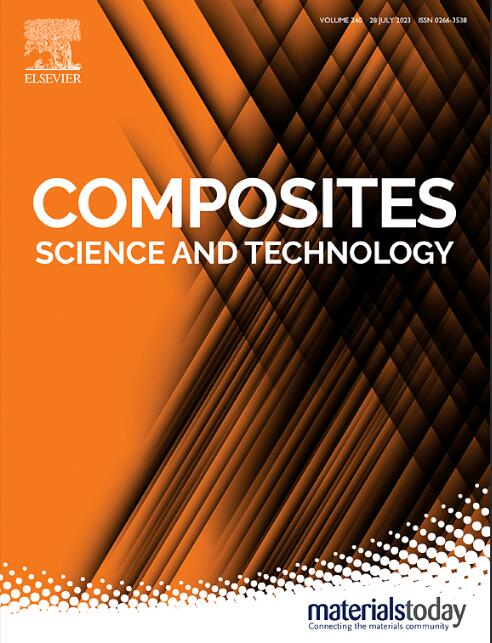石墨烯-碳纳米管结构对丁腈橡胶热液耐久性的多尺度协同增强
IF 8.3
1区 材料科学
Q1 MATERIALS SCIENCE, COMPOSITES
引用次数: 0
摘要
地热密封系统中丁腈橡胶(NBR)的水热失效是一个严峻的挑战。本研究采用溶液共混法制备了石墨烯/碳纳米管增强丁腈橡胶复合材料(GN/CNTs-NBR)。通过水扩散动力学、分子动力学模拟和多尺度结构表征的综合分析,阐明了填料协同效应对橡胶基体水热老化行为的抑制机理。实验结果表明,经过170℃/48 h时效处理后,GN/CNTs-NBR的抗拉强度保持在21.7 MPa,比原始NBR提高19.3%,膨胀率降低到13.0%(降低19.8%)。吸附等温线分析表明,填料网络使Langmuir平衡常数(KL)降低了17.6%(0.14),模型拟合良好(R2 = 0.98)。分子动力学模拟证实,与原始NBR相比,水分子扩散系数(0.69 × 10−7 cm2/s)降低了32.4%,范德华能提高了26.3%。限制分子链迁移率(MSD降低34.2%)和迟滞行为分析(能量耗散降低28.5%)共同验证了水热降解的多尺度抑制机制。这项工作为极端环境橡胶密封件的设计提供了新的见解。本文章由计算机程序翻译,如有差异,请以英文原文为准。
Multiscale synergistic enhancement of hydrothermal durability in NBR through graphene-carbon nanotube architectures
The hydrothermal failure of nitrile rubber (NBR) in geothermal sealing systems remains a critical challenge. This study fabricates graphene (GN)/carbon nanotubes (CNTs) reinforced NBR composites (GN/CNTs-NBR) via solution blending process. Through integrated analysis of water diffusion kinetics, molecular dynamics simulations, and multiscale structural characterization, we elucidate the inhibition mechanism of filler synergistic effects on hydrothermal aging behavior in rubber matrices. Experimental results demonstrate that the GN/CNTs-NBR maintains 21.7 MPa tensile strength after 170 °C/48 h aging, with a 19.3 % improvement over pristine NBR, while reducing the swelling ratio to 13.0 % (19.8 % decrease). Adsorption isotherm analysis reveals that the filler network reduces the Langmuir equilibrium constant (KL) by 17.6 % (0.14) with superior model fit (R2 = 0.98). Molecular dynamics simulations confirm a 32.4 % decrease in water molecular diffusion coefficient (0.69 × 10−7 cm2/s) and 26.3 % enhancement in Van der Waals energy compared to pristine NBR. The restricted molecular chain mobility (34.2 % MSD reduction) and hysteresis behavior analysis (28.5 % energy dissipation decrease) collectively validate the multiscale suppression mechanism of hydrothermal degradation. This work provides new insights for designing extreme-environment rubber seals.
求助全文
通过发布文献求助,成功后即可免费获取论文全文。
去求助
来源期刊

Composites Science and Technology
工程技术-材料科学:复合
CiteScore
16.20
自引率
9.90%
发文量
611
审稿时长
33 days
期刊介绍:
Composites Science and Technology publishes refereed original articles on the fundamental and applied science of engineering composites. The focus of this journal is on polymeric matrix composites with reinforcements/fillers ranging from nano- to macro-scale. CSTE encourages manuscripts reporting unique, innovative contributions to the physics, chemistry, materials science and applied mechanics aspects of advanced composites.
Besides traditional fiber reinforced composites, novel composites with significant potential for engineering applications are encouraged.
 求助内容:
求助内容: 应助结果提醒方式:
应助结果提醒方式:


